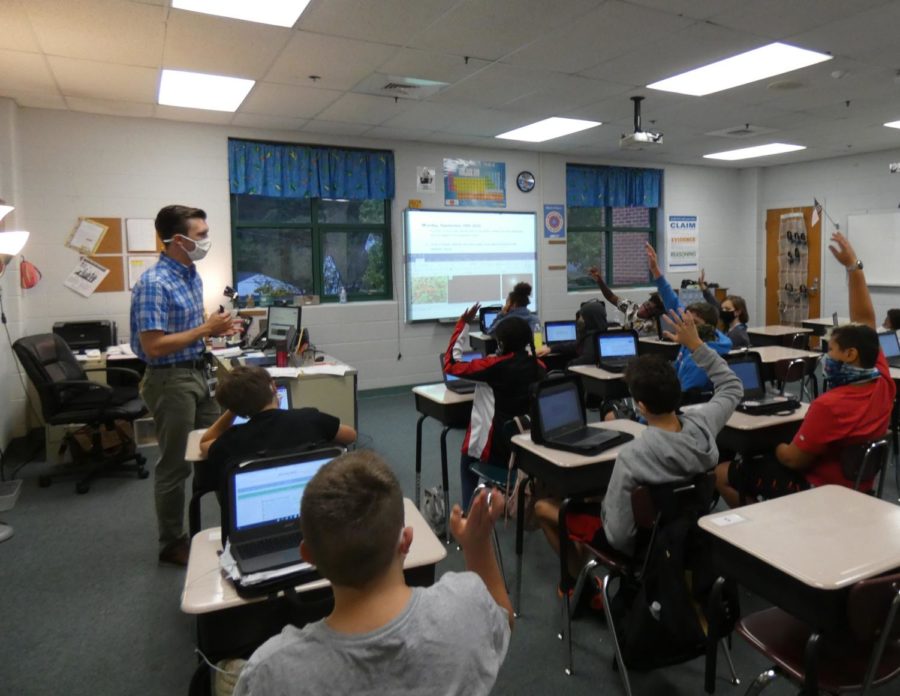Teacher turnover is an issue that schools face all over the country, and this obstacle has hit Sevier especially hard this year. Students were shocked when they found out almost twenty-six percent of full-time teachers have left Sevier this year.
Andy Cox is the Director of Teacher Education and the Education Department Chair at the University of Virginia’s College at Wise. As somebody who works to prepare new teachers for the profession, he is familiar with the problem of teacher turnover.
“Teacher turnover is the change of teachers from one year to the next in a specific position,” he said. “The term is not a good term to use, because it doesn’t really describe what is going on in a school. We can’t really determine from the term if someone changed positions in education or if they left the teaching profession altogether.”
While John Sevier lost nearly twenty-six percent of its full-time teachers, Tennessee overall ranks twenty-eighth in America for highest teacher turnover according to The Graide Network. Arizona ranks number one with a twenty-eight percent teacher turnover rate.
Hunter Mullins, the instructor of elementary and instrumental music at University School, has a different viewpoint.
“Another point of interest in the available data is that southern states tend to experience higher turnover than the rest of the nation,” Mullins said.
According to Brookings’ Brown Center, forty-two percent of American teachers have considered retiring, moving to a different school, or leaving the profession. A lot of those teachers only considered it, but never followed through.

Teacher turnover can have a big impact on students.
Nick Roebke, Associate Principal at Sevier Middle, has seen first-hand on how teacher turnover affects students.
“I think there are pros and cons with teacher turnover,” he said. “I think there’s always a benefit of getting someone with a different perspective coming in. But I think it’s also beneficial to have teachers who have experience and are more experienced in different situations.”
Mullins has a different perspective. He has spent the last two years conducting extensive research and writing about educator turnover.
“Some large studies have shown that excessive turnover has significant negative impacts on student achievement and school culture,” he said. “These negative impacts are worse for schools and students that were already struggling.”
The impacts of teacher turnover aren’t just on students, though.
Lisa Sanetti is a professor of school psychology at the University of Connecticut. She conducts research on how to support teachers’ delivery of interventions to help their students and how to improve teacher mental health and well-being.
“School districts, on average, spend more than $20,000 per new hire and the full dividend does not get paid until approximately 2 years after hire,” Sanetti said. “This is especially problematic as more and more teachers are leaving the field within their first 5 years.”
Mullins agrees.
“There are many hidden costs associated with teacher turnover,” he said. “The average cost to a school district to replace one teacher can be as high as $20,000 according to recent national statistics.”
According to the National Center for Education Statistics, eight percent of teachers leave the profession each year, while another eight percent change schools. Sevier lost nearly twenty-six percent of its full-time faculty this year.
Sanetti believes that many aspects of COVID-19 were, and still are, a major contributing factor to teachers leaving the profession this year.
According to Sanetti, one study completed since the start of COVID-19 pandemic indicates that teachers worked more hours during the pandemic. In addition, 60% enjoyed their job less and 25% of teachers indicated they are “just getting by” or are “having difficulty getting by” financially.
“About half of teachers reported not being able to pay for a $1,000 unexpected expense from their checking or savings accounts,” she said. “Teachers are incredibly highly exposed, interacting with dozens to over 100 students per day. That alone is a huge stressor, let alone figuring out online and hybrid models of instruction.”
Cox agrees.
“It is probably safe to write that COVID had a negative impact on just about everything,” he said. “There are lots of major research groups collecting data on teacher turnover caused by COVID and virtual learning.”
In a lot of cases, school systems can’t find enough teachers to fill the empty positions.
“Administrators may hire long-term substitutes who do not need to be certified teachers, leading to inadequate instruction,” Sanetti said. “Alternatively, administrators may hire teachers with ‘emergency certification’, [which means] they meet most, but not all requirements for certification in the state, which may also lead to inadequate instruction.”
At the beginning of this school year, several classrooms at Sevier were staffed with substitutes while the search for permanent teachers continued.

Kennedy Johnson, an eighth grade student at Sevier, experienced having a permanent substitute in her Language Arts class.
“I feel that it is hard on students to not have a teacher and have a sub, as I know a lot of kids did, at the beginning of the year due to a shortage of teachers,” she said. “It’s a lot harder to have a sub than to have a new teacher.”
Teacher turnover does not only have an effect on students, but other teachers, as well.
“The teachers who are remaining are likely to be even more stressed than usual,” Sanetti said. “Teachers report to me that turnover greatly decreases their sense of collegial support at work, can result in increased need to mentor new teachers, or take on additional responsibilities.”
Chris Carr, a seventh grade social studies teacher doesn’t mind lending a helping hand to new teachers.
“I remember what it was like to be a new teacher in a school, and how overwhelming it can be at times,” he said. “I’m always happy to help.”
The stress that is put on remaining teachers can affect the level of education students receive in their classes staffed with an experienced teacher.
“When teachers are chronically stressed, they are more likely to do a poorer job with academic instruction and behavior management and have poorer relationships with students,” Sanetti said.
School systems may be able to slow down teacher turnover, but first they have to address the causes.
“Right now, teacher stress and poor mental well-being is the primary reason teachers are leaving the field prior to retirement and is the #1 reason for the nationwide teacher shortage,” Sanetti said. “Teaching is tied with nursing as the most stressful occupation.”
This is common for almost all teachers across the nation.
“Results of a more recent study indicate this rate may be even higher, as nearly all teachers, 93%, reported high levels of stress,” Sanetti said.
Cox agreed.
“In the East Tennessee and Southwest Virginia areas, surveys indicate that teachers leave their schools because of stress, workloads, feeling undervalued, pressure to perform, pay, starting a family and teaching just wasn’t what they thought it was going to be,” he said.
Emroy Trent, an eighth grade student at Sevier Middle, has some ideas on how to decrease teacher turnover rates.
“I think students can help decrease teachers’ stress levels by just engaging in what’s going on in class and being respectful to teachers and students for a better working environment for everyone,” he said.
Kella Jackson, a seventh grade student, agreed.
“I think students could be nicer to teachers and they could be more respectful to their teachers,” she said.
Johnson has another way students can help decrease teacher turnover rates.
“Students ultimately could get their work done and not pile it all up to do at the end of the quarter,” she said. “They should focus and see how much this is affecting teachers. They should also try to be compassionate and help the teachers.”
School districts can also take part in decreasing teacher turnover rates.
“One of the most important things districts can do is select better leaders,” Mullins said. “Effective leadership is the single most important factor related to hiring and retaining effective teachers, and it starts at the top.”
Cox knows this is not the only reason for teacher turnover, though.
“The best way for schools to positively change teacher turnover is to determine what is causing it,” he said. “Since every school is different, an effort needs to be made to identify why teachers are leaving. Once the reasons are identified, changes can be made.”
At some schools, teachers work together and anonymously interview their colleagues and ask what areas the school or system could improve. They then take that information to the school board and try to get those issues fixed.
Sanetti agrees that each school has its own problems.
“The issues that have arisen in each school where I have done this work have been unique, such as poor communication from the principal, lack of access to the principal, lack of civility among teachers, considerable concerns about mold in certain school buildings, lack of recognition for work well done, and poor health insurance,” she said. “So, a one-size-fits all approach doesn’t work. But we were able to make headway in each school. School systems have to take some responsibility and ownership of the problem.”
Roebke is thankful for the teachers who remained at Sevier Middle this year.
“I’m really thankful for all the teachers that we do have here at Sevier,” he said. “They do a great job and I’m excited to see how the year goes this year.”
This story was originally published on The Sequoyah Scribe on November 12, 2021.







































